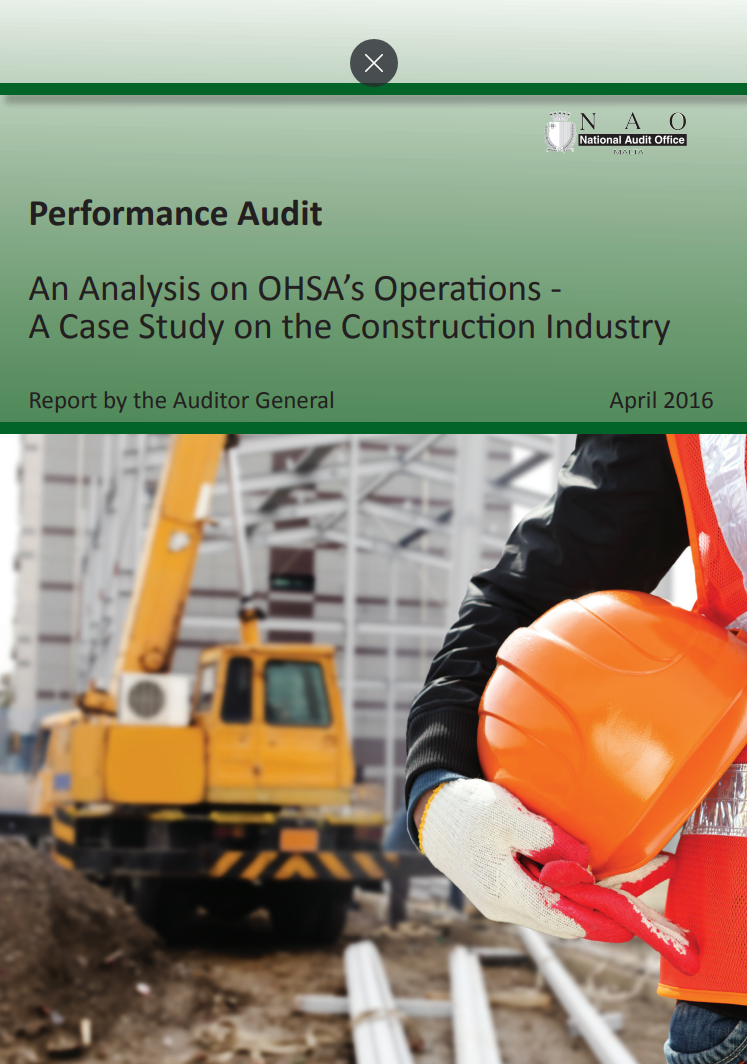- Home
- Publications
Publications
You may browse through our online list of NAO publications which include audit reports and annual reports. The audit reports are categorised according to the Classification of the Functions of Government (COFOG) developed by the OECD.
All Publications- Categories
- Publications Archive
- Events
- Careers
- About Us
 Economic Affairs April 2016
Economic Affairs April 2016Performance Audit: An Analysis on OHSA’s Operations – A Case Study on the Construction Industry
Download PublicationPress Release

Workers engaged in the local Construction Industry are the most at risk of suffering occupational accidents when compared to others working in other industrial sectors. In view of this, a statistical analysis was carried out by the National Audit Office (NAO) to test a number of quantifiable variables (namely the number of hours worked, weather variables and age of workers), that could have an effect or are associated with the risk of an occupational accident within the Construction industry. Results showed that only heat is strongly correlated with the occurrence of occupational accidents in the construction industry, which factor explains 31.5% variability in accident rates. NAO therefore notes that, apart from random variation, cultural disregard to Occupational Health and Safety (OHS) and regulatory slack are likely to explain the remaining 68.5% of the variability in accident rates.
With these considerations in mind, NAO carried out a Performance Audit to assess the efficiency and effectiveness of the Occupational Health and Safety Authority (OHSA) in safeguarding and regulating OHS considerations in the Construction Industry. Following its review, this Office primarily concludes that, while OHSA’s educational function are commended, the Authority should tighten and step-up its regulatory function through a thorough change in its operational philosophy, particularly by adopting a more pro-active and meticulous monitoring system together with stronger enforcement. This, NAO opines, is key to addressing a local cultural disregard to OHS.
This Office has reservations on the Authority’s practice of not carrying out exhaustive inspection visits on construction sites. This concern is further compounded by the fact that, although OHSA ascertains that the responsibility of a Project Supervisor (PS) is duly assigned (whose role is to make sure that OHS considerations are observed during all stages of a construction project), there is no rigid and comprehensive system by which the competence of all active PSs is assessed.
It was also observed that OHSA does not possess a comprehensive electronic data system and keeps its information in a fragmented manner. This, in NAO’s opinion, creates gaps in the Authority’s knowledge base with negative repercussions to its operational processes. NAO is also concerned that, through the current construction notification system, OHSA only has the potential visibility on projects which exceed a set threshold in terms of duration of works and number of workers deployed simultaneously. Apart from the fact that compliance to the current notification obligation is not comprehensively registered by the local industry, NAO is of the opinion that this set standard restricts OHSA’s information base, particularly as the local scenario may significantly feature smaller scale projects.
NAO further opines that the level of permissible financial penalties (both in the form of administrative fines as well as the minimum imposable fines should a case be taken to the Courts of Justice) are completely incommensurate to the nature of some of the infringements they are intended to deter. This element of disproportionality is made more evident when comparing these fines to the significantly higher costs attributed to the implementation of adequate OHS measures. As a consequence, this Office concludes that this significant difference between the enforceable fines and OHS related costs, may be incentivising duty holders to forego the implementation of adequate OHS measures and ‘risking’ a relatively minimal fine if detected by OHSA’s inspectorate staff.
NAO however also acknowledges that external factors, such as innate local cultural disregard to OHS considerations, legal constraints and other compounding factors (such as the considerable presence of irregular workers within this industry), create a regulatory conundrum which is not easily overcome. The significant shortage in the quantity of inspectorate staff (compared to international standards) at OHSA’s disposal, further adds unwarranted pressure on the Authority’s operations and creates gaps in the latter’s potential coverage.
These issues, along with others, are comprehensively addressed in the audit report in caption. A number of recommendations also feature in this publication.
